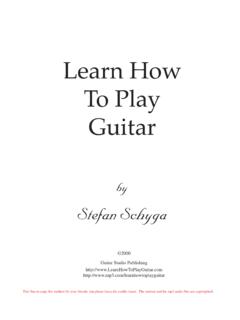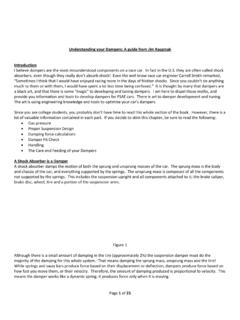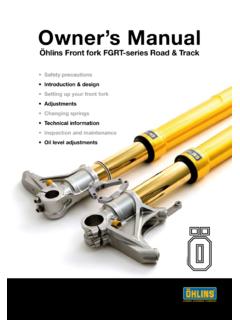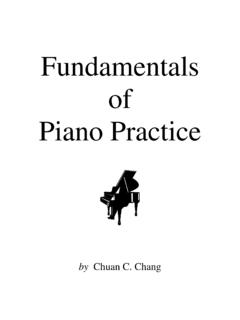Transcription of THE ESSENTIAL GUIDE TO STARTING OUT ON TABLA - Pete …
1 THE ESSENTIAL GUIDE TO STARTING ON TABLAPETE LOCKETTCONTENTSFOREWORDINTRODUCTIONWAYS TO PRACTICE THE MATERIALCHAPTERS1 THE DRUMS (A little background)2 THE WORDS OF THE DRUMS (Phonetics and vocalisations)3 RHYTHMS AND COMPOSITIONS (What they mean)4 HOW TO MAKE THOSE DRUMS SING (Basic note articulation)5 RHYTHM THEME ONE (Kaida)6 NEW STROKES7 RHYTHM THEME TWO (Kaida)8 RHYTHM THEME THREE (Kaida)9 NEW SYLLABLES (Bols)10 RHYTHM THEME FOUR (Laggi)11 RHYTHM THEME FIVE (ReIla. All that fast jazz)12 RHYTHM THEME SIX (Delhi Kaida) RHYTHM THEME SEVEN (ReIla)SEE MP3 S FOR ALL MUSICAL EXAMPLESINTRODUCTIONThis GUIDE represents a completely fresh approach to learningIndian TABLA and applying it in more familiar Westerncontexts. The book covers the subject in such a way as tomake the techniques and rhythmic frameworks totallyaccessible to anyone.
2 It comes with all examples representedwith an GUIDE starts by covering a brief history with generalinformation on the instrument with sections on playing styles,the phonetic vocal system, tuning and maintenance. Thereader learns the individual strokes on the drums with conciseyet detailed descriptions along with new stroke is introduced and is then incorporated into aset of patterns combining it with other strokes learnt up to thatpoint. No knowledge of sight-reading is required for GUIDE is an ideal STARTING point for anyone interested inplaying TABLA , whether they want to pursue a full classicalstudy of the instrument, or just simply learn a few basicpatterns and sounds for a session or two, or even just for funat home. The book is designed to be easily accessible and toopen the door of TABLA playing for TO PRACTICE THE MATERIALTo get the maximum benefit, work on each example thoroughly, concentrating on soundproduction and clarity.
3 Only move up a speed when you feel it is really strong and clearat a slower rhythmic theme has a few variations. Begin by practicing each of these seperatelyand then move on to playing the variations one after the other in a sequence, repeatingeach variation 1,2 or 4 times. Slowly build up the speed and try to memorise ll be surprised at how useful a long train journey can be when trying to memorisetabla is important to practice the material in the following three ways;1/Syllables only2/ Drums only3/ Drums and Syllables togetherOn the mp3 s, the theme and each variation is demonstrated very slowly, once with thesyllables and then just the , for selected compositions, the theme and its variations are repeated at twodifferent tempos in a sequence with each variation being repeated twice, firstly with thesyllables and then with the you approach any new material, listen to the relevant mp3 example and followthe syllables in the luck and I hope you enjoy the first steps of learning this incredible instrument andif you have any comments please email DrumsThe TABLA originates from North India and consists of a set of two drums, treble andbass.
4 They are distinct from most other drums in the world, in that each drum is playedwith a different hand. Very seldom do you see both hands playing on one drum. Thedrums have a regal history dating back centuries to the time of Princes and theirKingdoms where all Palaces had their own set of full time musicians, including performer sits on the floor with the drums in front of him, which are nestled in twosupporting rings called Adharas . The high pitched drum is cylindrical in shape andstands about 10 inches high. It is made from wood, usually shisham or nim, and ishollowed out from the top like a big cup, remaining sealed at the bottom. The drum hasonly one skin, generally about 5 inches in diameter. The shell is wider at the bottom thatthe top by about 1 1/2 bass TABLA is basically a small single headed kettle drum made from nickel alloy.
5 (Itis sometimes possible to find them made from clay.) Both drum heads (Puri) are madeform goat skin and have a complicated hoop (Pagri) which is woven around the edge ofthe skin. The skins are fixed to the drum with a long leather strap call Chot . This strapis threaded through the hoop and underneath the drum through a small leather inside and outside the skin ther is a thin rim about 1 inch wide running around theedge. this is called the kinar or Kani and is also made of goat long leather strap is pulled tight, bringing the drum skin to tension. The treble drumis pulled a lot tighter and needs small wooden blocks (Gattha) inserted between theshell and the straps to get it up to the pitch required. Sometimes you see smallerwooden blocks used for the bass TABLA . (In Benares a completely different method isused for the bass TABLA .)
6 They use rope and metal rings to get the tension.)The skins then have past patches applied to give the skins the resonance patches (Shyahi) are made from a paste of iron fillings, flour and ground hillstone. In India a chemical is also sometimes added to stop ants eating the patches. Thetreble drum is tuned by knocking the wooden blocks with a small hammer. Finer tuningis then carried out by hitting the leather hoop of the skin either up or down, dependingon the pitch drum is tuned to the tonic or dominant note in the scale of the piece of music to beplayed. It is important to bear in mind that Indian music does not change key and so, ifyou play music that does then you will need more than one high pitched TABLA at bass TABLA is generally not tuned to a particular pitch, largely because of theglissando technique that is used on that Indian phonetic systemBOLS (Literally word )As opposed to a system of written notation, Indian percussionists use a vocabulary, orsyllables to represent the patterns they play.
7 These words are intended to mimic thesounds that come from the drums. Each stroke and combination of strokes has its ownword or set of words. It is possible to look at these words as an alphabet of phrases,out of which longer and longer patterns are composed. The words have no semanticmeaning apart from the patterns they represent. Generally these words are the firstthing a student learns when learning a new composition. Once they get familiar with thewords of a composition they go on to playing it on the drums. It splits the difficulty oflearning a new piece into two, first leaning the rhythm of it and then the fingering andnote vocabulary you find in North Indian, Hindustani percussion is notably different fromthat of South Indian, Carnatic percussion, both in the words they use and also in thegeneral construction of the rhythmic compositional system.
8 Below is a list of the maintabla phonetics (bols) , including a GUIDE to ON THE DYNHA (smaller treble drum)TA I NA I RApronounced as in CARTIN pronounced as in TIN, the metalDINpronounced as in TIN, the metalREpronounced as in REPRIMANDTE pronounced as in TERRYTAK pronounced as in TACKTHET pronounced as in PETTHUN(see note in next section)TIpronounced as in TEADI pronounced as in capital letter D NEpronounced as in NECESSARYNUNG pronounced as in HUNG, with an N BOLS ON THE BYHA (larger bass drum)GE I GHE I GA(see note below)KE I KA I KO(see note below)KOTpronounced as in COTGAD pronounced as in GODBOLS INVOLVING BOTH DRUMS TOGETHERDHA(= GE + NA)pronounced as in CAR(see note below)DHIN 1(= GE + TIN)pronounced as in DINNER(see note below)DHIN 2(= GE + THUN)pronounced as in DINNER(see note beIow~DHE(= GE + TE)(see note below)KRE(= KE + TE, flam) pronounced with rolled R NOTE: The Indian pronounciation can be difficult for a westerner because they oftenstress the letter H when it is the second THREED ifferent sorts of rhythmic compositions used in the bookKaida compositions (Persian, lit:basis/procedure)Kaidas are nearly always the firstthings a TABLA player learns.)
9 They are often lengthy compositions consisting of a themewhich is developed over a number of variations, (Paltas) often up to as many as can end with a Tihai (a rhythmic phrase repeated three times, see section onTihais below) or a Chuckradah (a longer composition of three Tihais.)Rella compositions (Hindi, Lit: rushing I a flood I an assault)Another translation of Rella is Rail and was used to compare this style of compositionto a fast moving train. Rella s also come in theme and variation compositions (Hindi. Lit: links of a chain)Laggis are theme and variation compositions like Kaidas but are played with amuch ligthter touch. Laggis are more commonly found in Dholak playing.(Dholak is a North Indian folk drum.)It is also common to get some of these terms intertwined. For example, there are suchthings are Laggi Kaidas and rella (Lit: a third part)A Tihai is a rhythmical phrase which repeats three times and ends on the first beat ofthe time cycle.
10 They can be used in any time cycle and can start from anywhere in thebar, so long as they repeat three times and end on the first joy of Tihais is the syncopated and off beat feeling they create. Another point is thatthe audience gets to hear the phrase the first time, recognise it the second time andanticipate it the third time. Whether accompanying or playing solo, Indian percussionistsend nearly all improvisations with a Tihai or its longer counter part, the Chuckradah. Thebasic format would run like this:1 Basic time cycle - 2 Solo passage (Kaida, Rella etc)3 Tihai or Chuckradah - 4 Back to basic time cycleThere are many other sorts of compositions for TABLA such as Peshkar and Gat , but forthe purposes of this GUIDE we will keep to these few, along with the western stylerhythmic notations towards the final few , Time cycles and ThekaA Tal is the equivalent of the western time signature.





